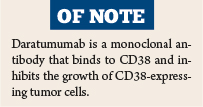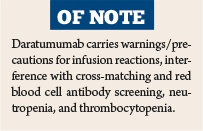In the Clinic provides overviews of novel oncology agents, addressing indications, mechanisms, administration recommendations, safety profiles, and other essential information needed for the appropriate clinical use of these drugs.
On November 21, 2016, daratumumab (Darzalex) was approved for use in combination with lenalidomide (Revlimid) and dexamethasone or with bortezomib (Velcade) and dexamethasone for the treatment of patients with multiple myeloma who have received at least one prior therapy.1,2 The drug was initially granted accelerated approval in November 2015, to treat patients with multiple myeloma who have received at least three prior treatments including a proteasome inhibitor and an immunomodulatory agent, or who are double-refractory to a proteasome inhibitor and an immunomodulatory agent.
Supporting Efficacy Data
Approval was based on two open-label phase III trials. In the POLLUX trial,3 569 patients were randomly assigned to daratumumab plus lenalidomide/dexamethasone (n = 286) or lenalidomide/dexamethasone (n = 283). In the CASTOR trial,4 498 patients were randomized to daratumumab plus bortezomib/dexamethasone (n = 251) or bortezomib/dexamethasone (n = 247).
In the POLLUX trial, median progression-free survival was not reached in the daratumumab group vs 18.4 months in the control group (hazard ratio [HR] = 0.37, P < .0001). In the CASTOR trial, median progression-free survival was not reached in the daratumumab group vs 7.2 months in the control group (HR = 0.39, P < .0001).
How It Works
The transmembrane glycoprotein CD38 is expressed on the surface of hematopoietic cells, including multiple myeloma and other cell types and tissues, and has multiple functions, including receptor-mediated adhesion, signaling, and modulation of cyclase and hydrolase activity.

Daratumumab is an IgG1κ human monoclonal antibody that binds to CD38 and inhibits the growth of CD38-expressing tumor cells by inducing apoptosis directly through Fc-mediated cross linking, as well as inducing immune-mediated tumor cell lysis through complement-dependent cytotoxicity, antibody-dependent cell-mediated cytotoxicity, and antibody-dependent cellular phagocytosis. Myeloid-derived suppressor cells and a subset of regulatory T cells express CD38 and are susceptible to daratumumab-mediated cell lysis.
How It Is Used
For use in combination with lenalidomide and dexamethasone, the recommended dose of daratumumab is 16 mg/kg via intravenous infusion weekly for weeks 1 to 8, every 2 weeks for weeks 9 to 24, and every 4 weeks from week 25 until disease progression. For use in combination with bortezomib/dexamethasone, the recommended dose of daratumumab is 16 mg/kg via intravenous infusion weekly for weeks 1 to 9, every 3 weeks for weeks 10 to 24, and every 4 weeks from week 25 until disease progression.
No dose reductions of daratumumab are recommended. Dose delay may be required to allow recovery of blood cell counts in cases of hematologic toxicity.
Pre- and postinfusion medications are specified below. The maximum infusion rate for all infusions is 200 mL/h. For the first infusion, the dilution volume should be 1,000 mL, with an infusion rate during the first hour of 50 mL/h and a rate increment of 50 mL/h every hour. For the second infusion, the infusion volume should be 500 mL, with an infusion rate of 50 mL/h and a rate increment of 50 mL/h every hour and with escalation occurring only if there were no grade ≥ 1 infusion reactions during the first 3 hours of the first infusion.
For subsequent infusions, the dilution volume should be 500 mL, with an infusion rate of 100 mL/h and a rate increment of 50 mL/h every hour. A modified initial rate should be used only if there were no grade ≥ 1 infusion reactions during a final infusion rate ≥ 100 mL/h in the first two infusions.
Expanded Approval of Daratumumab
- Daratumumab (Darzalex) is now approved for use with lenalidomide and dexamethasone or with bortezomib and dexamethasone for the treatment of patients with multiple myeloma who have received at least one prior therapy.
- For use in combination with lenalidomide and dexamethasone, the recommended dose of daratumumab is 16 mg/kg via intravenous infusion weekly for weeks 1 to 8, every 2 weeks for weeks 9 to 24, and every 4 weeks from week 25 until disease progression.
- For use in combination with bortezomib/dexamethasone, the recommended dose of daratumumab is 16 mg/kg via intravenous infusion weekly for weeks 1 to 9, every 3 weeks for weeks 10 to 24, and every 4 weeks from week 25 until disease progression.
Treatment should be immediately interrupted for infusion reactions of any grade. For grade 1 or 2 reactions that resolve, infusion should resume at no more than half the rate at which the reaction occurred. If no further reactions occur, the infusion escalation rate may resume. For the first 2 occurrences of grade 3 reactions, restarting the infusion at no more than half the rate at which the reaction occurred may be considered if symptoms resolve. Treatment should be permanently discontinued for a third occurrence of a grade ≥ 3 reaction and for the first occurrence of a grade 4 reaction.
Preinfusion medications should be given to all patients 1 to 3 hours before every infusion of daratumumab. These drugs consist of dexamethasone at 20 mg (intravenously prior to the first infusion, with consideration of oral administration prior to subsequent infusions), antipyretics (oral acetaminophen at 650–1,000 mg), and an antihistamine (oral or intravenous diphenhydramine at 25–50 mg or an equivalent).
For postinfusion medication, low-dose oral methylprednisolone (≤ 20 mg) or an equivalent on the day after the daratumumab infusion should be considered. However, if a background regimen-specific corticosteroid (eg, dexamethasone) is administered the day after the daratumumab infusion, additional postinfusion medications may not be needed.
Postinfusion medications such as short- and long-acting bronchodilators and inhaled corticosteroids should be considered for any patient with a history of chronic obstructive pulmonary disease. If the patient experiences no major infusion reactions after the first four infusions, these additional inhaled postinfusion medications may be discontinued. Antiviral prophylaxis to prevent herpes zoster reactivation should be started within 1 week after starting daratumumab and continued for 3 months following treatment.
Safety Profile
In the POLLUX trial, the most frequent adverse events occurring in at least 20% of the daratumumab group were infusion reactions, diarrhea, nausea, fatigue, pyrexia, upper respiratory tract infection, muscle spasms, cough, and dyspnea. Serious adverse events occurred in 49% of the daratumumab group vs 42% of the lenalidomide/dexamethasone group; those with an incidence at least 2% higher in the daratumumab group were pneumonia (12% vs 10%), upper respiratory tract infection (7% vs 4%), and influenza and pyrexia (3% vs 1% for each). Grade 3 or 4 neutropenia occurred in 53% vs 40%, respectively, and grade 3 or 4 thrombocytopenia occurred in 13% vs 15%. Adverse events resulted in discontinuation of treatment in 7% vs 8%.

In the CASTOR trial, the most frequent adverse events occurring in at least 20% of the daratumumab group were infusion reactions, diarrhea, peripheral edema, upper respiratory tract infection, peripheral sensory neuropathy, cough, and dyspnea. Serious adverse events occurred in 42% of the daratumumab group vs 34% of the bortezomib/dexamethasone group; those with an incidence at least 2% higher in the daratumumab group were upper respiratory tract infection (5% vs 2%) and diarrhea and atrial fibrillation (2% vs 0% for each). Grade 3 or 4 neutropenia occurred in 15% vs 5%, respectively, and grade 3 or 4 thrombocytopenia occurred in 47% vs 35%. Adverse events led to treatment discontinuation in 7% vs 9%.
Daratumumab carries warnings/precautions for infusion reactions, interference with cross-matching and red blood cell antibody screening, neutropenia, and thrombocytopenia. Patients should be typed and screened prior to starting treatment; if a patient needs a blood transfusion, the blood bank should be informed that a patient has received daratumumab. Complete blood cell counts should be monitored periodically during treatment. ■
References
1. U.S. Food and Drug Administration: Daratumumab (Darzalex). Available at www.fda.gov/Drugs/InformationOnDrugs/ApprovedDrugs/ucm530249.htm. Accessed November 29, 2016.
2. Darzalex (daratumumab) injection prescribing information. Janssen Biotech, Inc, November 2016. Available at www.accessdata.fda.gov/drugsatfda_docs/label/2016/761036s004lbl.pdf. Accessed November 29, 2016.

